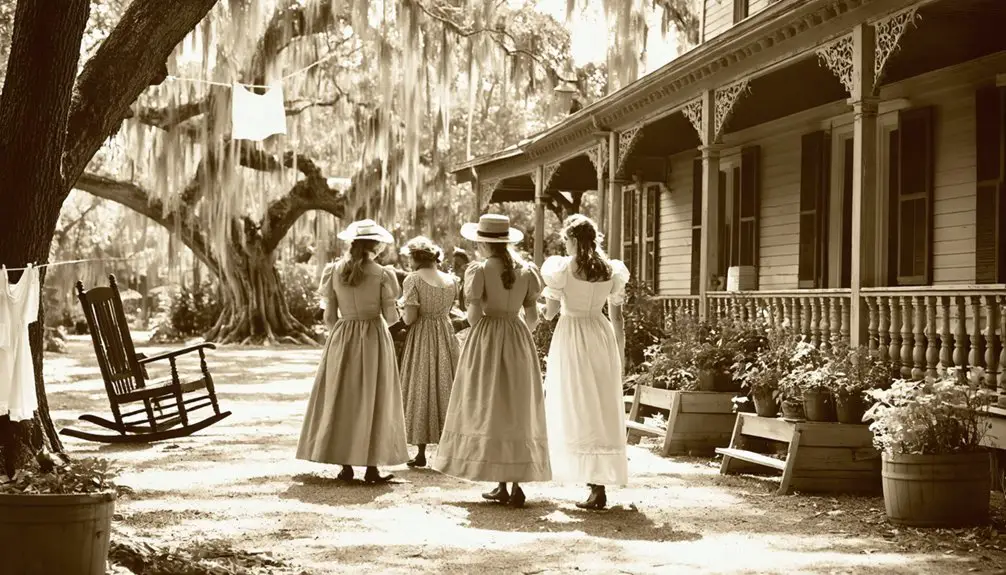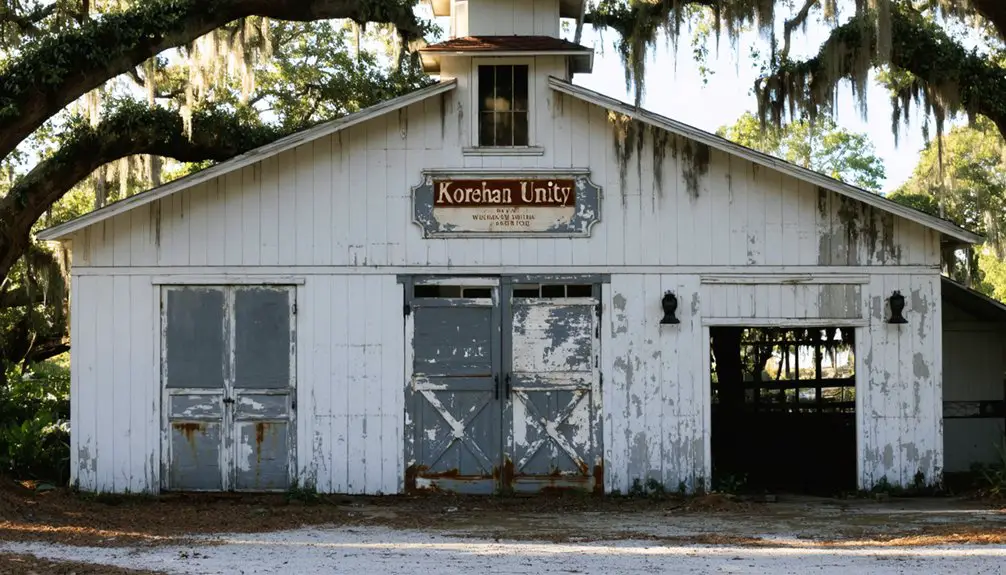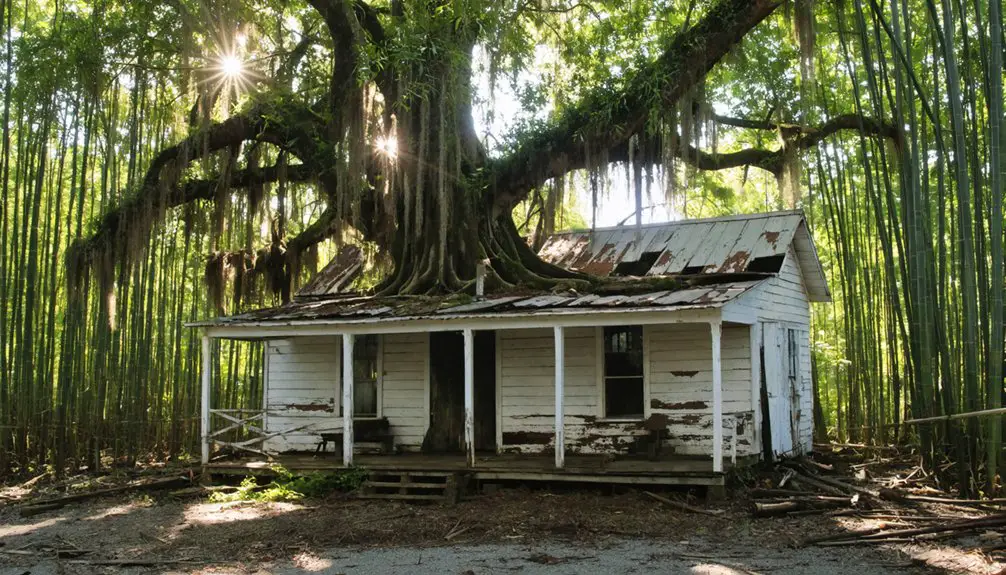You’ll discover the remnants of the Koreshan Unity Settlement, a fascinating 19th-century religious commune in Estero, Florida. Founded by Cyrus “Koresh” Teed, this self-sufficient community thrived with its own bakery, printing press, and electrical system. The settlement operated under unique beliefs, including that humans lived inside a hollow Earth. Today, you can explore 11 preserved historic structures at Koreshan State Historic Site, where mysterious phenomena continue to intrigue visitors.
Key Takeaways
- Koreshan was a religious commune in Florida founded by Cyrus Teed that transformed from a thriving settlement into an abandoned ghost town.
- The settlement featured 11 original structures that still stand today at the Koreshan State Historic Site in Estero, Florida.
- After Teed’s death in 1908, the community gradually declined until the last member transferred the property to Florida in 1961.
- The ghost town includes preserved industrial buildings, living quarters, and the Planetary Court where the community’s female leadership resided.
- Visitors can explore the abandoned settlement through guided tours that showcase the commune’s unique history and unexplained phenomena.
The Visionary Behind Koreshan Unity
While many utopian communities emerged in 19th century America, few had a leader as intriguing as Cyrus Reed Teed, the founder of Koreshan Unity.
Born in 1839, you’ll find his transformation from physician to prophet began when he adopted the Hebrew name “Koresh,” meaning shepherd. Cyrus Teed’s teachings combined mysticism with pseudoscientific claims, including his signature belief that humanity existed inside a giant sphere – the hollow earth theory.
Teed’s journey from medicine to mysticism led him to preach that humans lived inside Earth, not upon it.
In the 1870s, you’d have witnessed him establish Koreshan Unity’s beliefs around celibacy, communal living, and the pursuit of immortality. Under his guidance, the Koreshans formed a unique governing body called the Planetary Court of women. His early roots included working on the Erie Canal as a young boy.
His vision attracted roughly 250 devoted followers who’d help build a self-sufficient community in Estero, Florida, which he dubbed the “New Jerusalem.” Teed led his faithful until his death in 1908.
A Radical Scientific Worldview
You’ll find that Koreshan beliefs centered on a radical scientific model claiming humanity lived inside a hollow sphere rather than on its outer surface.
To validate this theory, Koreshan followers conducted extensive experiments along Naples Beach in 1897, using sophisticated surveying equipment to measure what they believed was the earth’s concave curvature.
The movement also published scientific papers and treatises through their printing press, attempting to legitimize their unique cosmological worldview that merged metaphysical beliefs with empirical observation.
Their foundational text “Cellular Cosmogony” outlined their complete theories about Earth existing as a concave sphere in 1905.
Their leader Cyrus R. Teed practiced Eclectic Medicine and experienced an epiphany in 1869 that inspired his unconventional theories.
Universe Inside Hollow Sphere
Since the early days of the Koreshan settlement, its followers embraced a radical scientific worldview centered on the belief that the entire universe existed within a hollow sphere.
You’ll find their view challenged conventional physics, suggesting that rather than living on a convex Earth’s surface, humanity resided inside a cosmic web of celestial bodies.
Their hollow universe theory proposed that light traveled in curved paths along the sphere’s interior, explaining phenomena like sunrise and sunset through an alternative lens.
The Koreshans developed complex mathematical models to support their beliefs, arguing that objects would contract or expand relative to their position within the sphere. This aligned with emerging ideas about the universe containing vast cosmic voids alongside dense clusters of matter.
While modern science has disproven these theories, they represent a fascinating chapter in alternative cosmological thinking, showcasing humanity’s enduring quest to understand our place in the universe. Their beliefs gained significant attention when Nazi officials explored similar hollow Earth theories in the 1930s.
Experimental Proof Methods
The Koreshan Unity‘s devotion to scientific experimentation set them apart from other religious communes of their era.
You’ll find their experimental methodology was deeply rooted in both spiritual and scientific pursuits, as they sought to prove their radical hollow earth theory through measurable tests and observations. After Cyrus Teed’s death in 1908, the community’s scientific pursuits began to gradually decline as they awaited his promised resurrection. Led by the Planetary Sisters, the community maintained rigorous documentation of their experiments and findings.
- Community experiments included testing horizon curvature and gravity effects to validate their internal universe model.
- Practical facilities like sawmills, cement works, and printing houses served as living laboratories.
- Followers conducted systematic observations of natural phenomena, including Teed’s death, which they viewed as a scientific-spiritual experiment.
Their commitment to blending faith with investigative practices created a unique approach to scientific proof, where daily life in their Florida settlement became an ongoing experiment in validating their worldview through direct observation and practical application.
Scientific Publication Legacy
Beyond their physical experiments, Koreshanity’s scientific legacy lives on through an extensive collection of published works and radical cosmological theories.
You’ll find their alternative cosmology detailed in numerous scientific publications, including their local newspaper and materials from the World College of Life, all boldly proclaiming “We live inside!” Their writings challenged Newtonian physics and conventional gravity, presenting a unique blend of alchemy, spiritualism, and pseudo-scientific reasoning.
The community’s founder Cyrus Teed led the development of these unconventional theories until his death in 1908, marking a turning point for the movement’s scientific pursuits.
While their concave Earth theory didn’t withstand scientific scrutiny, these preserved documents at the Koreshan State Historic Site offer valuable insights into 19th-century scientific utopianism.
The community’s extensive print culture, combining religious doctrine with scientific claims, demonstrates how radical thinkers sought to merge emerging scientific principles with spiritual beliefs during America’s shifting period.
Building a Self-Sufficient Paradise
You’ll find it remarkable how the Koreshans transformed their swampy Florida settlement into an industrial powerhouse, complete with a sawmill, boatworks, steam laundry, and concrete works.
Their self-generated electricity system, operating from 1916 to 1946, not only powered their commune but also supplied neighboring areas with surplus power.
Through their innovative community works program, the Koreshans established thriving enterprises like their popular bakery, which produced “risin’ bread” for both internal consumption and external sale.
The community’s dedication to agriculture helped them achieve sustainability through their tropical fruit orchard, which provided fresh produce for the settlement.
Industrial Innovation Triumphs
While many utopian communities struggled to achieve true self-sufficiency, Koreshan’s industrial innovations set it apart as a remarkably autonomous settlement in late 19th century Florida.
You’ll find evidence of their pioneering spirit in the extensive network of industrial facilities they built, from printing works to boat yards. They didn’t just survive – they thrived by creating innovative utilities that powered both their settlement and neighboring areas.
- Their machine shop, equipped with the 1929 Fairbanks-Morse Engine, showcased their mechanical prowess
- They pioneered electricity distribution in rural Florida, a remarkable feat for the era
- Their sawmill, bakery, and cement works formed a complete industrial ecosystem
These achievements demonstrate how the Koreshans transformed their utopian vision into a self-sustaining reality through industrial ingenuity and determination.
Community Works Program Success
The Koreshan Unity’s community works program stands as a masterpiece of self-sufficiency, integrating education, industry, and agriculture into a thriving ecosystem.
You’ll find community education seamlessly woven into daily life, with academic studies in the mornings and vocational training in the afternoons, preparing members for diverse roles across the settlement.
From the bustling bakery producing 400 loaves daily to the industrial might of their sawmill and boat works, you can trace how the Koreshans built a remarkable closed-loop economy.
They cultivated Victorian gardens alongside food crops, operated their own store and post office, and maintained extensive workshops.
Through collective ownership and operation of these facilities, they achieved true independence, supporting a population of 300 at their peak while fostering a skilled, multi-talented workforce.
Daily Life in the Koreshan Settlement

Life in the Koreshan settlement revolved around a structured daily routine that balanced work, education, and cultural pursuits.
You’d start your day with extensive educational programs focused on reading, writing, and arithmetic, followed by vocational training in trades like baking, printing, and construction.
After your daily work, you’d find yourself immersed in a vibrant cultural atmosphere filled with musical performances and theatrical events.
- Mornings were dedicated to learning, while afternoons focused on developing practical skills
- You’d contribute to the community’s self-sufficiency through work in the bakery, gardens, or printing press
- Your evenings might include attending lectures at the Art Hall or enjoying performances at Bamboo Landing
The settlement’s infrastructure supported this lifestyle, with shared facilities ensuring everyone could participate in the community’s diverse activities.
The Mysterious Death of Cyrus Teed
Amid the structured routines of Koreshan life, a dramatic event would alter the community’s trajectory forever. On October 13, 1906, Cyrus Teed sustained severe injuries while breaking up a fight at the Ft. Myers train station. His health gradually declined over two years until his death on December 22, 1908 – the Winter Solstice.
You’ll find that Teed’s followers maintained an unwavering vigil over his body, expecting his resurrection on Christmas Day as prophesied in his book “The Immortal Manhood.”
When signs of decay appeared, authorities ordered his burial on December 27. Though a 1921 hurricane damaged his tomb on Estero Island, followers recovered his skull and some bones.
Teed’s death marked the beginning of the settlement’s slow decline, leading to its eventual transformation into a historic district.
From Religious Community to Historic Park

Following Cyrus Teed’s death in 1908, the Koreshan Unity‘s transformation from religious commune to historic landmark unfolded gradually over five decades.
After their leader’s passing, the Koreshan Unity slowly evolved from a spiritual settlement into a preserved piece of Florida’s unique history.
You’ll find remnants of their unique lifestyle preserved within the 305 acres that the last followers deeded to Florida in 1961. The site’s transformation from a hub of Koreshan rituals and communal living to a state park guarantees their legacy lives on.
- 11 original structures dating from 1882-1920 showcase the community’s architectural heritage
- Exotic gardens and landscaping demonstrate their global botanical interests
- Educational exhibits help you explore their unique blend of science, spirituality, and utopian ideals
Today, you can walk the same paths where 200 believers once lived, worked, and pursued their vision of a perfect society inside Koreshan State Park.
Haunted Grounds and Unexplained Phenomena
Since its transformation into a state park, Koreshan’s grounds have gained notoriety for unexplained phenomena that draw paranormal enthusiasts from across the country.
You’ll encounter reports of ghostly apparitions, including the spirit of Cyrus Teed himself and his devoted followers still awaiting his resurrection. The “Lady in White” often appears on trails, accompanied by spectral singing that echoes through the grounds.
As you explore the historic buildings, you might hear unexplained sounds – disembodied voices, mysterious footsteps, and inexplicable knocking noises that pierce the silence.
Visitors regularly experience sudden cold spots on trails and glimpse shadowy figures that vanish without explanation. The disappearance of Teed’s coffin during a hurricane only deepens the mystique of this haunted settlement.
Preserving a Unique Florida Legacy

When the last Koreshan member Hedwig Michel ceded the commune’s grounds to Florida in 1961, she guaranteed the preservation of a remarkable chapter in the state’s history.
Today, you’ll find this utopian preservation site showcasing rare 19th-century communal architecture through meticulously maintained buildings and grounds.
- The Art Hall still features its original wood paneling and stage where Thomas Edison and Henry Ford once attended concerts.
- You can explore the three-story dining hall, bakery, and machine shops that highlight the community’s self-sufficiency.
- The site’s crushed-shell paths wind through groves of palms, oaks, and magnolias planted by the Koreshans themselves.
Through guided tours and exhibits, you’ll discover the fascinating story of this unique religious commune, from their hollow Earth beliefs to their progressive political efforts and eventual decline.
Frequently Asked Questions
What Languages Were Commonly Spoken Among Koreshan Unity Members?
You’ll find language diversity centered on English as the primary tongue, with German common among European immigrants. Hebrew had cultural influences through religious practices, though mainly symbolically.
Did Any Original Koreshan Unity Members Have Descendants Who Still Live Nearby?
You’ll find several descendants of original Koreshan Unity members still living near Estero, preserving their local heritage through descendants’ stories, though most family connections aren’t widely documented in public records.
What Happened to the Original Koreshan Unity Financial Assets and Records?
Like seeds planted in Florida soil, the Koreshan Unity’s financial legacy lives on. You’ll find their assets transferred to state parks, while their records remain preserved at Koreshan State Historic Site for research.
Were There Any Notable Conflicts Between Koreshans and Neighboring Florida Communities?
You’ll find significant Koreshan conflicts emerged around 1906, including violent street confrontations, political tensions, and social hostility with neighboring communities, culminating in leader Cyrus Teed’s brutal beating by local authorities.
Did Any Other Religious Groups Attempt to Establish Settlements Near Koreshan?
Like an isolated island in a spiritual sea, you won’t find evidence of other religious settlements near Koreshan. Historical records show the area’s spiritual conflicts were between Koreshans and existing local Christians.
References
- https://www.floridahauntedhouses.com/real-haunt/koreshan-state-historic-site.html
- https://treelinerealty.com/blog/-the-vanishing-prophet-of-koreshan-state-park-when-a-cult-leaders-body-was-swept-out-to-sea
- https://www.messynessychic.com/2021/08/31/the-ghost-town-left-behind-by-an-american-sect-of-hollow-earth-believers/
- https://www.floridastateparks.org/parks-and-trails/koreshan-state-park/history
- https://www.visitflorida.com/travel-ideas/articles/arts-history-koreshan-state-historic-site/
- https://en.wikipedia.org/wiki/Koreshan_Unity
- https://en.wikipedia.org/wiki/Cyrus_Teed
- https://southernmysteries.podbean.com/e/cyrusteedkoreshanunity/
- https://archive.naplesnews.com/community/photos-exploring-the-history-of-the-koreshan-unity-in-estero-ep-386914085-331588041.html/
- https://en.wikipedia.org/wiki/Koreshanity



